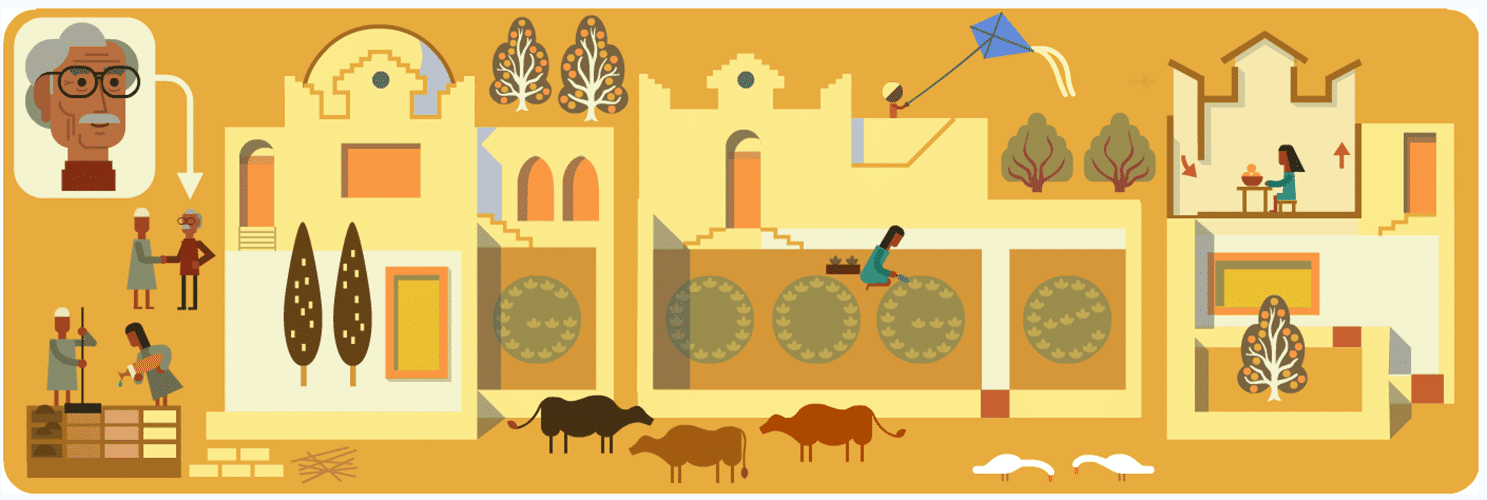Hassan Fathy: Architectural Pioneer of Sustainable Design

Image Courtesy: Google Doodle
Hassan Fathy (23 March 1900 – 30 November 1989) was an Egyptian architect known for his pioneering work in sustainable and vernacular architecture. He was a strong advocate for the use of traditional building techniques and materials, and his work had a significant impact on architecture in Egypt and beyond.
Life and Career
Fathy was born in Alexandria, Egypt, on 23 March 1900. He studied architecture at the University of Cairo, and later at the University of Grenoble in France. He was heavily influenced by the work of Le Corbusier and other modernist architects, but he also became interested in traditional Egyptian building techniques and materials.
In the 1940s, Fathy began to develop his own approach to architecture, which he called “New Gourna.” This approach was based on the use of traditional building techniques, such as mud brick construction, and the incorporation of local materials and designs. Fathy believed that this approach was not only more sustainable and affordable than modernist architecture, but also more in harmony with the natural environment.
Fathy’s most famous project was the village of New Gourna, which he designed in the 1940s. The village was built for the people of the old Gourna village, which had been destroyed to make way for the nearby Luxor temple. Fathy’s design for New Gourna incorporated traditional building techniques and materials, such as mud brick construction and palm frond roofs, and was intended to be affordable and sustainable for the local residents.
Throughout his career, Fathy designed a wide range of buildings, from private homes to public buildings, schools, and mosques. His work was widely admired for its innovative use of traditional materials and techniques, and for its ability to create buildings that were both beautiful and functional. Fathy’s work had a significant impact on architecture in Egypt and beyond. He became known as the “father of sustainable architecture,” and his ideas and techniques influenced architects around the world. Today, Fathy is widely regarded as one of the most important architects of the 20th century, and his work continues to inspire architects and designers who are interested in sustainable and vernacular architecture. Hassan Fathy died on 30 November 1989 in Cairo, Egypt.
Award and Legacy
Hassan Fathy’s contributions to architecture and sustainable design have been recognized with numerous awards and honors. In 1980, he was awarded the Right Livelihood Award, also known as the “Alternative Nobel Prize,” for his work in promoting sustainable and affordable housing. He was also awarded the Aga Khan Award for Architecture in 1983.
Fathy’s legacy continues to inspire architects and designers around the world. His innovative use of traditional building techniques and materials, and his commitment to sustainability and social justice, have had a significant impact on the field of architecture. Many of his buildings and designs are now considered iconic examples of sustainable and vernacular architecture.
Fathy’s influence can be seen in the work of many contemporary architects and designers, who continue to draw inspiration from his ideas and techniques. His legacy also lives on through the work of organizations such as the Hassan Fathy Foundation, which is dedicated to promoting sustainable architecture and preserving Fathy’s legacy. Overall, Hassan Fathy is remembered as a visionary architect who challenged conventional thinking about architecture and sustainability, and who believed that architecture had the power to create social and environmental change. On 23 March 2017, Google celebrated Hassan Fathy’s 117th birthday with a doodle.
Observer Voice is the one stop site for National, International news, Sports, Editor’s Choice, Art/culture contents, Quotes and much more. We also cover historical contents. Historical contents includes World History, Indian History, and what happened today. The website also covers Entertainment across the India and World.
Follow Us on Twitter, Instagram, Facebook, & LinkedIn

